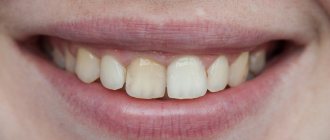“The child’s molar is loose. What to do? Is it possible to cure it at home? - these are typical questions often discussed in specialized sections of popular women's forums. Dentists never cease to be amazed at the recommendations that, in such cases, are given by more “experienced” forum users. Some advise not to worry and wait until the baby teeth are completely replaced with molars. Others recommend not to disturb the tooth again, not to loosen the tooth, and to switch your son or daughter to soft food “so that it doesn’t hurt.” Fortunately, the only correct advice is quite common - to take the heir to a pediatric dentist, who will understand the causes of the problem, prescribe and carry out adequate treatment.
“A new tooth is shaking” is really not always a reason to panic
During the period of change of bite, which starts at the age of 5–6 years, children's baby teeth begin to loosen. Following this, permanent ones appear who will have to faithfully serve the matured child throughout his life. The process of eruption of molars has its own characteristics.
- First, the dental crown appears, and the root that holds it in the jaw bone remains incompletely formed at this point.
- Therefore, for some time (usually no more than a year), a molar that is not firmly fixed can actually wobble slightly, and then it will strengthen naturally.
By the way, it is useful for adult dental patients to know that normally all permanent teeth have so-called physiological mobility. Our teeth are fixed in the bone alveolus with the help of a ligamentous apparatus, periodontium. Periodontal tissues perform shock-absorbing functions, evenly distributing the mechanical chewing load over the entire dentition and preventing the destruction of individual teeth under the influence of fairly serious chewing pressure. Few non-specialists know that with the help of the chewing muscles, our jaws can develop a force of up to 300–400 kg, depending on the consistency of the chewed products.
But if a mother notices that a child of 8–10 years old has a permanent tooth loose, the mobility is pronounced and accompanied by pain, the gums are swollen, and the child is also capricious and refuses to eat, it is necessary to urgently go for a consultation to pediatric dentistry. It is better to play it safe and exclude pathological mobility in order to prevent the possibility of premature loss of a tooth.
How does calcium deficiency manifest itself?
An irresistible urge to chew chalk is a classic symptom of calcium deficiency. But even if you don’t think about anything like that, your body can still send appropriate signals.
The following symptoms will help diagnose a deficiency: increased bone fragility, caries, periodontitis and crumbling of teeth, muscle spasms and cramps, numbness of the limbs, a feeling of “crawling” in the fingers, back and neck pain, abnormal heart rate, difficulty concentrating.
If one or more of these symptoms is detected, you should consult a doctor: he will help you adjust the diet of the expectant mother.
The recommended daily intake of calcium for a pregnant woman is 1300 mg, and for a nursing woman - 1400 mg. The absorption of calcium and phosphorus in the intestine is facilitated by vitamin D, which is produced under the influence of sunlight and can also be obtained from food. Taking into account the peculiarities of our climate, in addition to daily walks, the doctor may prescribe medications containing this vitamin to a pregnant or nursing mother.
Read our article for useful information on preventing calcium deficiency.
Typical causes of loose molars in children
- In the process of natural replacement of temporary teeth with permanent ones, mobile, restless children often injure their faces. A strong blow to the jaw can damage the surrounding soft tissues and lead to dislocation and fracture of the tooth. The damaged tooth will become mobile.
- In children, during a change in bite, inflammatory processes often occur in the oral cavity - in particular, gingivitis, inflammation of the gums.
- Only erupted molars are particularly susceptible to acid-forming bacteria. Quite often, carious cavities form in places that are difficult to access and are detected only when the child’s molar is already loose.
- Recently, children often have weak, loose gums. If hygiene is insufficient, they are easily affected by pathogenic bacteria and become inflamed. Periodontitis that occurs in children leads to loosening of teeth.
- The cause of the problem can also be diseases of internal organs caused by pathological metabolic processes and impaired blood supply.
- The genetic factor also plays a certain role. Cases of premature loss of healthy teeth that often occur in families may indicate an inherited predisposition to insufficient fixation of dental roots in bone tissue.
Factors such as poor nutrition, decreased immunity, abnormal bite, bruxism, and, during puberty, hormonal changes also increase risks.
Calcium and nutrition during pregnancy
Calcium is one of the most important macroelements in the human body. It is a building material for the skeletal system: 99% of calcium is concentrated in bones and teeth. In addition, it plays an important role in the proper functioning of the muscular, nervous, cardiac, circulatory and hormonal systems, as well as in the activation of enzymes that convert food into energy. Therefore, if low levels of calcium are detected in the blood, the body takes it from bone tissue to make up for the deficiency in these systems.
It is especially important for pregnant women and nursing mothers to get enough calcium. And vitamin K, in particular its variety, vitamin K2, which is found, for example, in Agusha curds, helps this element integrate into the bones.
Be sure to read our article about vitamin K2 and notes from the famous baby nutrition expert V.M. Kodentsova about the importance of vitamin K2 for the development of a child.
The need for calcium during pregnancy increases, since now this element is used not only for the needs of the woman’s body, but also for the construction of fetal bone tissue. To avoid calcium deficiency, you need to think through the diet in such a way as to prevent it from being washed out of the woman’s bones and teeth, and this is what happens when the fetus does not have enough calcium from the mother’s diet to build the skeleton. A sufficient amount of this macronutrient in a woman’s diet, including during pregnancy, is necessary to prevent the manifestations of osteoporosis.
- It is useful to include dairy products in the expectant mother's diet: cottage cheese, yogurt, milk, kefir, hard cheeses, as well as fatty fish. There is a lot of calcium in green leafy vegetables (for example, 100 g of spinach contains up to 106 mg), legumes: beans, soybeans, beans, parsley (another “champion” - up to 245 mg per 100 g of product).
- Celery, white cabbage, almonds, and greens also contain calcium.
Read more about nutrition during pregnancy in our special material “Eating Healthy During Pregnancy.”
Treatment of caries in children - prevention of loose teeth
The enamel of newly erupted permanent teeth is incomplete and continues to form over several years, so it is easily damaged by pathogenic microflora. Even with an almost imperceptible defect on the surface of the tooth, the looser dental tissues located under the layer of hard enamel will be affected very quickly.
The attending physician will assess the degree of destruction of dental tissues and decide on the possibility of treatment. If you do not postpone your visit to the clinic, as a rule, there is no need to resort to tooth extraction in your child. Modern dentistry has effective materials and technologies that allow high-quality restoration of a damaged tooth. In addition to filling with high-quality photocomposites, inserts and crowns are used that retain the ability to fully chew food.
How do you know when it's time to see a doctor?
Tooth enamel hypoplasia is a disease that is difficult to miss. The child has the following symptoms:
- Deterioration of the enamel. The top layer of teeth becomes thinner and cracks appear on it;
- A carious layer appears on the teeth;
- The baby suffers from tooth sensitivity: he reacts to cold, hot, sweet.
Despite the fact that tooth enamel is the strongest tissue in the body, it cannot regenerate on its own. If symptoms of thinning are detected, parents should consult a doctor with their baby as soon as possible.
How are gingivitis and periodontitis treated in a child?
Inflammatory diseases of the gum tissue can very quickly lead to loosening of permanent teeth. Therefore, it is so important not to miss the early symptoms of periodontitis in children - first of all, swelling of the gums and the appearance of blood when brushing teeth and eating solid foods.
The main cause of the development of inflammatory diseases is soft plaque, which remains due to poor quality teeth cleaning. Over time, it hardens, forming supra- and subgingival tartar. Hard periodontal deposits first cause inflammation of the mucous membrane, then the process covers periodontal tissue and bone tissue. “Dissolved” tissues no longer fix the permanent tooth, and it becomes loose. If treatment is not started, the child's teeth will fall out.
In some children, periodontitis may be caused by a lack of blood supply to the tissues. This usually occurs in the absence of the necessary chewing load. Parents should ensure that their children eat enough solid vegetables and fruits. In addition, it is necessary to bite and chew food not on one side of the dentition, but on both. In this case, the load on the teeth will be distributed evenly.
Treatment of gums begins with the removal of soft plaque and tartar, for which professional teeth cleaning for children is performed. Anti-inflammatory therapy is then prescribed according to the severity of the disease. In some cases, splinting of teeth is indicated - a procedure that prevents their further loosening. At the clinic, the child will be taught how to brush his teeth correctly, and the parents’ task will be to carefully monitor hygiene procedures at home and, if necessary, brush their son or daughter’s teeth.
Is it possible to completely restore enamel on your own?
Contrary to the fact that many want to see a positive answer in this section, there will not be one. If the coating began to deteriorate, then there were contributing factors, which do not always depend on whether the person cracked nuts with his teeth or not. You can only partially slow down this process before you can visit the dentist’s office and take drastic measures.
For protection, doctors offer the thinnest veneers. They are not felt in the mouth, do not bring the slightest discomfort, but at the same time, ceramics prevent microorganisms from reaching the protective shell and penetrating deep into the crown. In addition, the doctor can coat the dental plates with a fluoridating or remineralizing composition, which will prevent destruction for a long time. Therefore, to the question: how and whether it is possible to restore enamel on teeth at all, the answer will only be denial.
What factors worsen the health of baby teeth?
- Mechanical factors: impacts, bruxism, strong compression. They lead to changes in the tooth and disruption of its integrity.
- Chemical factors: prolonged exposure to sweets on the loose enamel of children's teeth.
- Bacterial factor: the spread of bacteria in the baby’s mouth.
- Sudden temperature changes when eating or drinking.
At what age should a child be taken to the dentist for the first time?
According to the WHO schedule, you should go to the dentist for the first time when the child is 9 months old. Some doctors indicate an age of 11-12 months. During a dental examination, several parameters are assessed.
1. How many teeth are there?
Based on the number of teeth present, the child’s development is assessed and pathologies are diagnosed. It is normal for children to erupt 5-8 milk teeth by the age of 9-12 months.
2. What condition are the teeth in?
From the first days of teeth appearing there is a danger of caries. Also, teeth should be examined for non-carious lesions - hypoplasia, in order to exclude the appearance and development of caries.
3. What is the condition of the mucous membranes?
Small children put everything in their mouths, so they are at risk for infectious diseases - stomatitis and intestinal infections. The more common fungal form of stomatitis, which must be treated promptly to avoid complications.
At the age of 9-12 months, a dental examination is more necessary for preventive purposes. The doctor will tell you what toothpaste to use, what toothbrush to choose, and how to teach your child hygiene. Until the child reaches two or three years of age, visits to the dentist should be regular - every 3-5 months.











